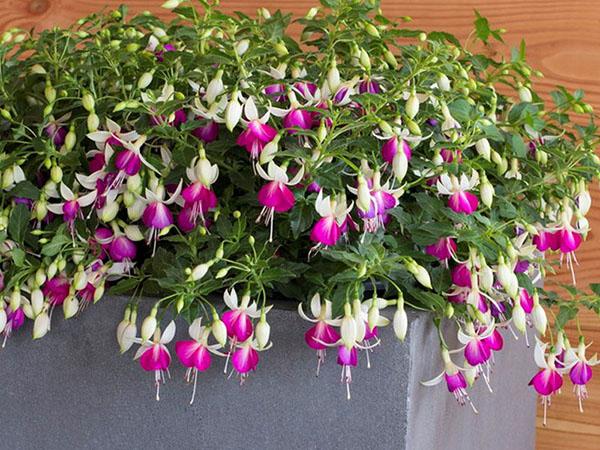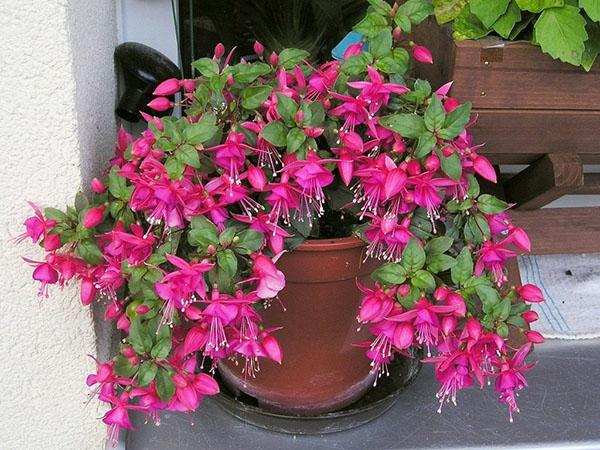Reproduction of fuchsia by cuttings at home: tips and tricks
 Reproduction of fuchsia by cuttings at home is one of the simplest ways to breed a flower you like. A lot of experience and serious knowledge is not required for this - it is enough to act carefully and according to the rules.
Reproduction of fuchsia by cuttings at home is one of the simplest ways to breed a flower you like. A lot of experience and serious knowledge is not required for this - it is enough to act carefully and according to the rules.
Features of breeding fuchsia

Flower growers practice 3 methods of reproduction:
- seeds;
- sheet;
- by cuttings.
The first and second methods are quite time consuming and have no guaranteed result. Breeding with cuttings is usually easy, they take root easily and begin to grow.
The cultivation of fuchsia for decorative purposes has a history of over 250 years.
Several cuttings can be cut from an adult plant without damage.
Reproduction of fuchsia by cuttings at home
 The optimal breeding time is March and February. In summer, due to the heat, rooting is more difficult and requires more effort.
The optimal breeding time is March and February. In summer, due to the heat, rooting is more difficult and requires more effort.
Stage 1. Preparing cuttings
 How to cut fuchsia? For harvesting cuttings, healthy shoots from 10 to 12 cm long are selected. They should have 4-6 paired leaves and a top. The cut is made at an angle using a sharp knife.
How to cut fuchsia? For harvesting cuttings, healthy shoots from 10 to 12 cm long are selected. They should have 4-6 paired leaves and a top. The cut is made at an angle using a sharp knife.
If the leaves on the handle are too large or there are more of them than necessary, some are cut off. When old shoots are selected for propagation, rooting will be slower.
Cutting off shoots for grafting is carried out after the flowering of the parent plant is completed.
After cutting, the cuttings are dried for a quarter of an hour. After that, it is advisable to treat the cut site with a special agent that will stimulate the formation of roots, for example, "Kornevin".
Stage 2. Substrate preparation
 How to root fuchsia with cuttings? To do this, prepare a small container, even plastic containers and disposable cups are suitable. For the purpose of germination, you can use various options for substrates.
How to root fuchsia with cuttings? To do this, prepare a small container, even plastic containers and disposable cups are suitable. For the purpose of germination, you can use various options for substrates.
This could be:
- earthen mixture;
- peat tablet;
- planting palette;
- plain water.
| P / p No. | Rooting mix | Characteristic |
| 1. | Plain water | This is the easiest way. It is enough to prepare a small vessel with purified water. Additionally, you can add a coal tablet to it, which will serve as a prevention of decay. |
| 2. | Peat tablet | It is pre-moistened with hot water for swelling. This is a very good rooting medium. |
| 3. | Earth mix | The mixture should be moist, well loosened |
| 4. | Planting palette
| The filler should contain the following components:
|
How to plant fuchsia cuttings? The stalk is placed in a prepared container, slightly deepening so that the leaves existing on it are above the ground.
Stage 3. Creation of greenhouse conditions
 After planting, the cutting needs to create a microclimate. For this, the container is covered with glass or film. To prevent condensation from accumulating and moisture to stagnate, the glass is periodically raised.
After planting, the cutting needs to create a microclimate. For this, the container is covered with glass or film. To prevent condensation from accumulating and moisture to stagnate, the glass is periodically raised.
It is important that the temperature is kept around + 25 ° C, and that bright sunlight does not fall on the plants. If the soil dries up, it must be moistened, and the water in the glass must be topped up.
After 14-20 days, when roots have appeared, new plants gradually wean from life in a greenhouse.To do this, they begin to remove the glass for some time, gradually increasing the time spent without a greenhouse until full daylight hours.
Stage 4. Transplant
 After the cutting has taken place and rooting has occurred, a new plant needs to be transplanted. Readiness for transplanting is determined by the fact that the roots have braided all the earth in a small vessel. Small flower pots can be used as a new container.
After the cutting has taken place and rooting has occurred, a new plant needs to be transplanted. Readiness for transplanting is determined by the fact that the roots have braided all the earth in a small vessel. Small flower pots can be used as a new container.
Reproduction of fuchsia by cuttings at home requires planting in soil with neutral acidity. A drain is placed at the bottom of the sampled container.
The transplanting process is traumatic for fuchsia due to the fragility of its roots. After placing in a new container, the plant is watered with warm water.
Further care
 Fuchsia, which has taken root and started to grow, needs proper care.
Fuchsia, which has taken root and started to grow, needs proper care.
Caring for a plant includes following these rules:
- Maintaining the air temperature within the range from + 18 ° C to + 24 ° C.
- Daily spraying during the warm season.
- Good lighting.
- Moderate soil moisture when the top layer dries.
- Application of complex fertilizers as top dressing.
- Annual transplantation into new soil rich in mineral composition.
- Loosening the soil.
- During the flowering period, the plant is not rearranged or touched.
- Maintaining good air humidity - at least 50%.
- Removing flowers that have wilted.
Reproduction of fuchsia by cuttings at home is an easy way, allowing you to quickly get a new plant that will completely inherit all the qualities of the parent. The elegant flowers of this plant are amazing decorations for window sills, loggias, balconies and terraces.